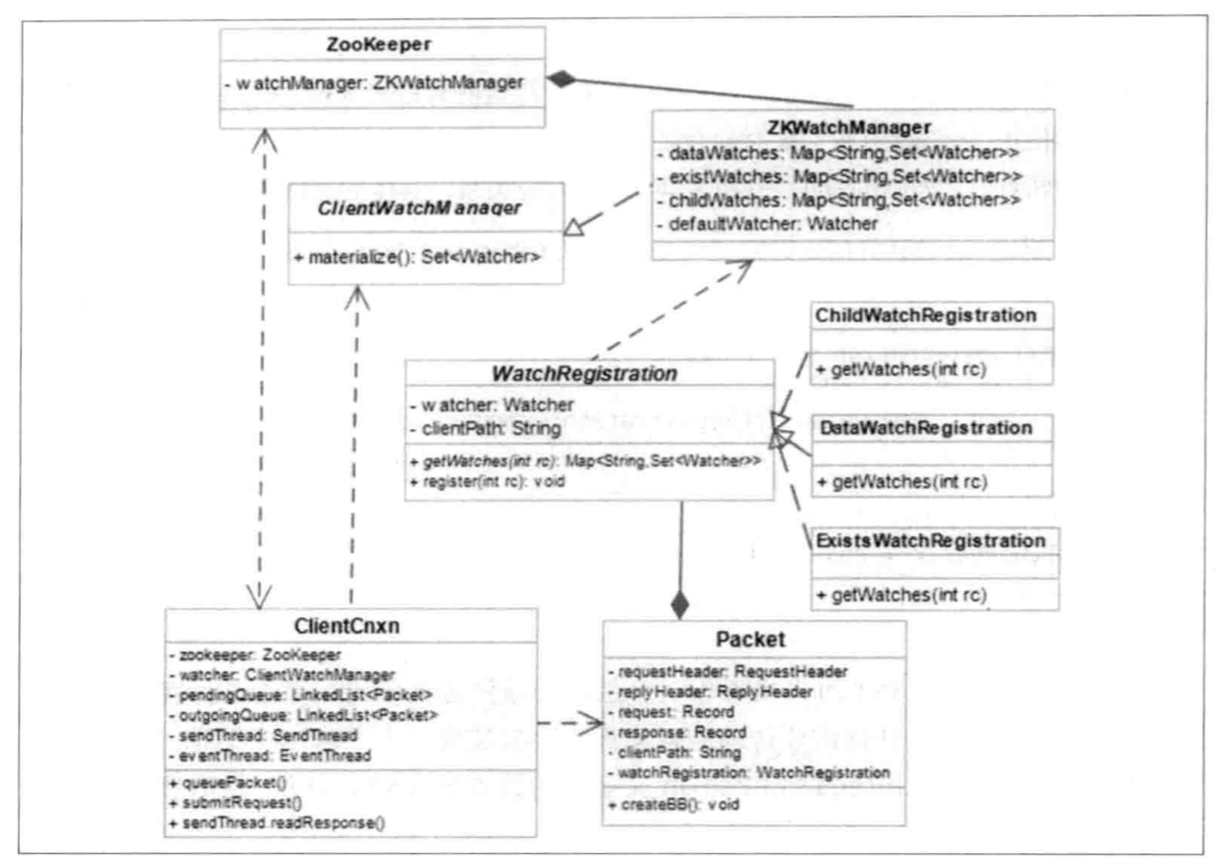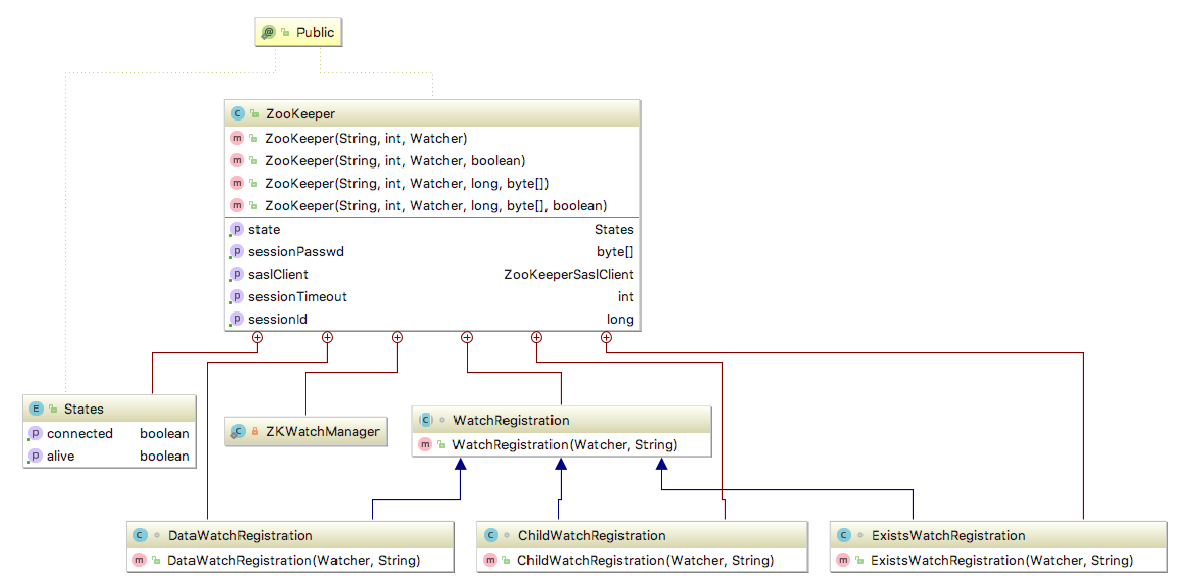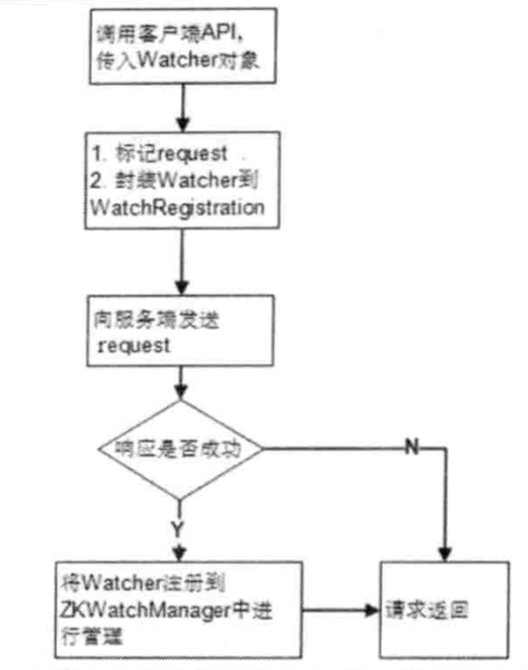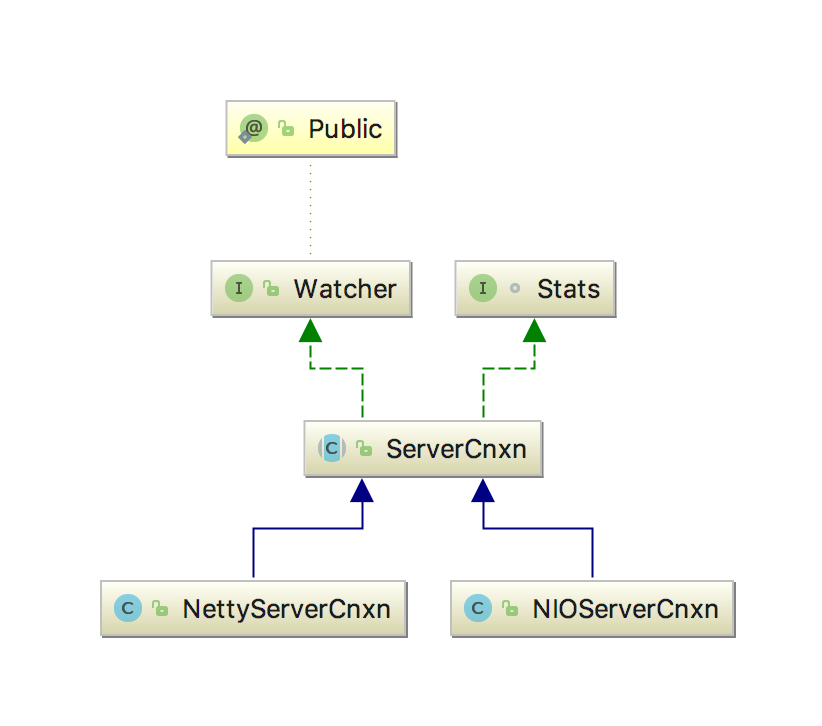前言
前面两篇主要说了关于watcher在客户端和服务端的相关实体类和功能接口的相关代码,这一篇把前面的两篇的这些实体类和功能接口以及整个watcher的相关框架串联起来,整体地说一下zk的watcher的注册,触发等运行的机制。
总的来说,ZK的watcher机制,主要可以分为三个阶段:
- 客户端注册watcher;
- 服务端处理watcher;
- 客户端回调watcher。
这三个过程的相关类的交互关系如下:

注册
使用过ZK原生api的同学都清楚,向zookeeper中注册watcher的接口大概有如下几个:
- 建立zk连接时传入的watcher;
- 通过getdata, exist, getchildren来设置watcher,而它们又各有同步和异步两种形式。
在zk的代码中,这两类注册的方式都在Zookeeper类中, Zookeeper类的内部结构如下:

通过原生的api去set watcher大概有如下的方法:
//构造器
public ZooKeeper(String connectString, int sessionTimeout, Watcher watcher)
public ZooKeeper(String connectString, int sessionTimeout, Watcher watcher, boolean canBeReadOnly)
public ZooKeeper(String connectString, int sessionTimeout, Watcher watcher, long sessionId, byte[] sessionPasswd)
public ZooKeeper(String connectString, int sessionTimeout, Watcher watcher, long sessionId, byte[] sessionPasswd, boolean canBeReadOnly)
//getData
public byte[] getData(final String path, Watcher watcher, Stat stat)
public void getData(final String path, Watcher watcher, DataCallback cb, Object ctx)
//exists
public Stat exists(final String path, Watcher watcher)
public void exists(final String path, Watcher watcher, StatCallback cb, Object ctx)
//getchildren
public List<String> getChildren(final String path, Watcher watcher)
public void getChildren(final String path, Watcher watcher, ChildrenCallback cb, Object ctx)
public List<String> getChildren(final String path, Watcher watcher, Stat stat)
public void getChildren(final String path, Watcher watcher, Children2Callback cb, Object ctx)首先是第一类通过构造器注册的:
public ZooKeeper(String connectString, int sessionTimeout, Watcher watcher,
boolean canBeReadOnly)
throws IOException
{
LOG.info("Initiating client connection, connectString=" + connectString
+ " sessionTimeout=" + sessionTimeout + " watcher=" + watcher);
//把传入的watcher注册到default的watcher中,(留心就可以发现getdata,exists,getchildren提供了参数为boolean类型,参数名为watch的接口,调用这些接口触发的就是default的watcher)
watchManager.defaultWatcher = watcher;可以看到,通过构造器传入的默认watcher会注册到ZKWatchManager类型的变量watchManager中。
然后是通过另外三个接口注册的watcher,其实也是分为两种情况的,以getData为例,getData方法的watcher参数在有的接口中为boolean型有的中为Watcher类型。
Watcher类型:
public byte[] getData(final String path, Watcher watcher, Stat stat)
throws KeeperException, InterruptedException
{
final String clientPath = path; //记录znode的path
PathUtils.validatePath(clientPath);//path的合法性验证
// the watch contains the un-chroot path
WatchRegistration wcb = null;
if (watcher != null) {
wcb = new DataWatchRegistration(watcher, clientPath);//生成datawatch的对象
}
final String serverPath = prependChroot(clientPath);//chroot是zk启动时配置的默认前缀,前面有提到过的
//生成request的相关类
RequestHeader h = new RequestHeader();
h.setType(ZooDefs.OpCode.getData);
GetDataRequest request = new GetDataRequest();
request.setPath(serverPath);
request.setWatch(watcher != null);
GetDataResponse response = new GetDataResponse();
//发送请求
ReplyHeader r = cnxn.submitRequest(h, request, response, wcb);
if (r.getErr() != 0) {
throw KeeperException.create(KeeperException.Code.get(r.getErr()),
clientPath);
}
if (stat != null) {
DataTree.copyStat(response.getStat(), stat);
}
return response.getData();
}简单看一下getData的watcher注册流程,getChildren和exists和getData和这个也是类似的。
Boolean类型:
public byte[] getData(String path, boolean watch, Stat stat)
throws KeeperException, InterruptedException {
//可以看到就是调用了Watcher类型的接口,只是如果传入的是true,那么就默认使用在构造器中传入的默认watcher
return getData(path, watch ? watchManager.defaultWatcher : null, stat);
}可以通过上面的接口看到,通过接口设置的watcher会生成对应类型的watcher。在Zookeeper类中,WatchRegistration是一个抽象类,是三种负责注册的类(DataWatchRegistration, ChildWatchRegistration, ExistsWatchRegistration)的父类。
WatchRegistration
/**
* Register a watcher for a particular path.
*/
abstract class WatchRegistration {
private Watcher watcher; //注册的watcher
private String clientPath; //znode的path
public WatchRegistration(Watcher watcher, String clientPath)//构造器
{
this.watcher = watcher;
this.clientPath = clientPath;
}
//抽象方法,获取znode path和对应的watcher set的map关系
abstract protected Map<String, Set<Watcher>> getWatches(int rc);
/**
* Register the watcher with the set of watches on path.
* @param rc the result code of the operation that attempted to
* add the watch on the path.
*/
//根据添加watcher的response码来注册watcher
//在clientCnxn中调用p.watchRegistration.register(p.replyHeader.getErr());
public void register(int rc) {
if (shouldAddWatch(rc)) {//如果rc即response code为0则添加
Map<String, Set<Watcher>> watches = getWatches(rc);//获取所有已经注册的path和watcher的map关系
synchronized(watches) {
Set<Watcher> watchers = watches.get(clientPath);//找到此次注册的watcher的znode的path
if (watchers == null) {//若之前没有watcher,则新建watcher的set
watchers = new HashSet<Watcher>();
watches.put(clientPath, watchers);
}
watchers.add(watcher);//把watcher添加到全局对应关系中
}
}
}
/**
* Determine whether the watch should be added based on return code.
* @param rc the result code of the operation that attempted to add the
* watch on the node
* @return true if the watch should be added, otw false
*/
protected boolean shouldAddWatch(int rc) {//判断是否应该添加
return rc == 0; //rc=0即为添加信号
}
}看过了父类的方法,三个子类的就很好理解了:
/** Handle the special case of exists watches - they add a watcher
* even in the case where NONODE result code is returned.
*/
class ExistsWatchRegistration extends WatchRegistration {
public ExistsWatchRegistration(Watcher watcher, String clientPath) {
super(watcher, clientPath);//父类构造方法
}
@Override
protected Map<String, Set<Watcher>> getWatches(int rc) {
//这里有点疑问,为什么会有data的watches
//应该是加watch的时候可能会出现no node的情况,这种情况下才放到existwatches里去处理,不然都是datawatches
return rc == 0 ? watchManager.dataWatches : watchManager.existWatches;
}
@Override
protected boolean shouldAddWatch(int rc) {
//返回码是0或者是NONODE时添加
return rc == 0 || rc == KeeperException.Code.NONODE.intValue();
}
}
class DataWatchRegistration extends WatchRegistration {
public DataWatchRegistration(Watcher watcher, String clientPath) {
super(watcher, clientPath);
}
@Override
protected Map<String, Set<Watcher>> getWatches(int rc) {
//获取datawatch
return watchManager.dataWatches;
}
}
class ChildWatchRegistration extends WatchRegistration {
public ChildWatchRegistration(Watcher watcher, String clientPath) {
super(watcher, clientPath);
}
@Override
protected Map<String, Set<Watcher>> getWatches(int rc) {
//获取childwatch
return watchManager.childWatches;
}
}看到这里,结合之前两篇说的内容,可以知道,当利用API添加watch时,zk客户端会把watcher生成对应的Registration对象,然后发送添加请求到服务端,根据服务端的返回结果把Registration对象注册到ZKWatchManager对应的watch map中。接下来详细说下客户端发送请求的流程(getData为例)。
首先是getData的请求部分代码:
//生成request的相关类
RequestHeader h = new RequestHeader();
h.setType(ZooDefs.OpCode.getData);//设置请求类型
GetDataRequest request = new GetDataRequest();//生成可序列化的getdatarequest
request.setPath(serverPath);//设置path和watcher
request.setWatch(watcher != null);
GetDataResponse response = new GetDataResponse();//生成可序列化的getdataresponse
//发送请求
ReplyHeader r = cnxn.submitRequest(h, request, response, wcb);
if (r.getErr() != 0) {
throw KeeperException.create(KeeperException.Code.get(r.getErr()),
clientPath);
}可以看到,DataWatchRegistration和request/response对象一进入了clientCnxn的submitRequest方法。
public ReplyHeader submitRequest(RequestHeader h, Record request,
Record response, WatchRegistration watchRegistration)
throws InterruptedException {
ReplyHeader r = new ReplyHeader();
//把传入的参数传入queuePacket
Packet packet = queuePacket(h, r, request, response, null, null, null,
null, watchRegistration);
synchronized (packet) {
while (!packet.finished) {//判断packet是否处理完,没有就wait
packet.wait();
}
}
return r;
}Packet queuePacket(RequestHeader h, ReplyHeader r, Record request,
Record response, AsyncCallback cb, String clientPath,
String serverPath, Object ctx, WatchRegistration watchRegistration)
{
Packet packet = null;
// Note that we do not generate the Xid for the packet yet. It is
// generated later at send-time, by an implementation of ClientCnxnSocket::doIO(),
// where the packet is actually sent.
//在这里并没有为packet生成xid
synchronized (outgoingQueue) {
packet = new Packet(h, r, request, response, watchRegistration);//初始化packet
packet.cb = cb;//属性赋值,注册watcher时回调为空
packet.ctx = ctx;
packet.clientPath = clientPath;
packet.serverPath = serverPath;
if (!state.isAlive() || closing) {//判断当前的连接状态
conLossPacket(packet);
} else {
// If the client is asking to close the session then
// mark as closing
if (h.getType() == OpCode.closeSession) {
closing = true;
}
outgoingQueue.add(packet);//把packet放入队列中(生产者)
}
}
sendThread.getClientCnxnSocket().wakeupCnxn();
return packet;
}问题来了,每次在队列中添加了一个watch的registration之后是谁消费的呢?
在ClientCnxn类中有一个sendThread线程的run方法里,clientCnxnSocket.doTransport(to, pendingQueue, outgoingQueue, ClientCnxn.this);这个方法就是负责消费队列里的registration的。
其中,ClientCnxnSocketNIO是clientCnxnSocket的默认实现类,后面会大致说一下。
在ClientCnxnSocketNIO的doTransport方法中调用了doIO(pendingQueue, outgoingQueue, cnxn);方法,这里是负责具体的序列化及IO的工作。其中p.createBB();方法是负责具体的序列化的工作。
public void createBB() {
try {
ByteArrayOutputStream baos = new ByteArrayOutputStream();//stream和archive的初始化
BinaryOutputArchive boa = BinaryOutputArchive.getArchive(baos);
boa.writeInt(-1, "len"); // We'll fill this in later
if (requestHeader != null) {
requestHeader.serialize(boa, "header");//序列化header,内容包含znode的路径和是否有watcher,这里很重要,server解析这里知道某个znode是否被watch
}
if (request instanceof ConnectRequest) {
request.serialize(boa, "connect");//序列化connect
// append "am-I-allowed-to-be-readonly" flag
boa.writeBool(readOnly, "readOnly");
} else if (request != null) {
request.serialize(boa, "request");//序列化request
}
baos.close();
this.bb = ByteBuffer.wrap(baos.toByteArray());
this.bb.putInt(this.bb.capacity() - 4);
this.bb.rewind();
} catch (IOException e) {
LOG.warn("Ignoring unexpected exception", e);
}
}可以看到,zk只会把request和header进行初始化,也就是说,尽管watchregistration也作为一个参数传入,但是在序列化时并没有去吧watchregistration转换成二进制。这也就代表了客户端每调用一次watcher的注册接口,watcher本身并不会被发送到服务端去。这样做的好处是如果所有的watcher实体都被上传到服务端去,随着集群规模的扩大,那么服务端的压力就会越来越大。而zk这样的处理方式则很好的保证了zk的性能不会随着规模和watcher1数量的扩展出现明显的下降。
注册到ZKWatchManager
在doIO里有readResponse方法负责读取从server端获取的byte。其中finishPacket会从Packet中取出Watcher并注册到ZKWatchManager中。
private void finishPacket(Packet p) {
if (p.watchRegistration != null) {//registration不为空
p.watchRegistration.register(p.replyHeader.getErr());//根据返回码注册
}
if (p.cb == null) {//同步方式
synchronized (p) {
p.finished = true;
p.notifyAll();//响应之前的wait
}
} else {//异步方式
p.finished = true;
eventThread.queuePacket(p);
}
}这里的register就是之前说过的三种watchregistration里的register方法了。这样就把watcher注册到了zk客户端中,同时服务端也获取到了每个znode是否被watch。
注册总结
《从paxos到zk》中有一张图描述了注册的整个过程:

总结一下流程:
- 用户通过三种接口或者zk构造器方式传入watcher对象;
- 封装Packet对象(包含znode是否watch的信息),并把packet放入队列;
- ClientCnxn.sendThread是队列的消费者,讲packet取出并序列化(此时只序列化了znode是否watch的消息,并没有序列化整个watchregistration)发送给server;
- server处理后返回结果给客户端,这个具体过程后面详细说;
- ClientCnxn.sendThread读取server端的回复,并把znode和watcher的对应关系注册到ZKWatchManager中。
服务端处理
首先,通过简单的时序图来了解下server端处理watcher的流程:

按照这个流程来了解server端是如何处理watcher相关的请求的。以FinalRequestProcessor中processRequest里getdata类型的请求为例:
case OpCode.getData: {
lastOp = "GETD";
//初始化getdata的request,内容是path和是否watch( 初始化均为空)
GetDataRequest getDataRequest = new GetDataRequest();
ByteBufferInputStream.byteBuffer2Record(request.request,
getDataRequest);//把request反序列化到getDataRequest
DataNode n = zks.getZKDatabase().getNode(getDataRequest.getPath());//获取对应的node
if (n == null) {//异常处理
throw new KeeperException.NoNodeException();
}
PrepRequestProcessor.checkACL(zks, zks.getZKDatabase().aclForNode(n),
ZooDefs.Perms.READ,
request.authInfo);//检查是否有权限访问
Stat stat = new Stat();
byte b[] = zks.getZKDatabase().getData(getDataRequest.getPath(), stat,
getDataRequest.getWatch() ? cnxn : null);//注意这里,获取是否watch
rsp = new GetDataResponse(b, stat);//包装response
break;
}getDataRequest.getWatch() ? cnxn : null上面代码中,这里有点特殊的地方,如果watch存在会获取一个名为cnxn的ServerCnxn类型的变量。ServerCnxn,代表了一个服务端与客户端的连接。类图如下:

可以看到ServerCnxn实现了Watcher接口,实际上后面的回调也是通过serverCnxn实现的。
同时在processRequest里,客户端传过来的消息会被传入ZookeeperServer的processTxn方法。
if (request.hdr != null) {
TxnHeader hdr = request.hdr;//header,包含请求类型
Record txn = request.txn;//request,路径和是否watch
rc = zks.processTxn(hdr, txn);
}public ProcessTxnResult processTxn(TxnHeader hdr, Record txn) {
ProcessTxnResult rc;
int opCode = hdr.getType();
long sessionId = hdr.getClientId();
rc = getZKDatabase().processTxn(hdr, txn);//dataTree相关的操作,更新树
if (opCode == OpCode.createSession) {//是否是创建连接
if (txn instanceof CreateSessionTxn) {
CreateSessionTxn cst = (CreateSessionTxn) txn;
sessionTracker.addSession(sessionId, cst
.getTimeOut());
} else {
LOG.warn("*****>>>>> Got "
+ txn.getClass() + " "
+ txn.toString());
}
} else if (opCode == OpCode.closeSession) {//是否是关连接
sessionTracker.removeSession(sessionId);
}
return rc;
}这是和datatree相关的一些操作。而上面的getdata的请求处理中进入了zkdatabase的getdata方法,而它的内部实际上调用了datatree的getdata方法。
public byte[] getData(String path, Stat stat, Watcher watcher)
throws KeeperException.NoNodeException {
DataNode n = nodes.get(path);//获取对应的node
if (n == null) {
throw new KeeperException.NoNodeException();
}
synchronized (n) {
n.copyStat(stat);//更新stat
if (watcher != null) {
dataWatches.addWatch(path, watcher);//注册watcher
}
return n.data;//返回节点的data
}
}dataWatches.addWatch(path, watcher);之前介绍过Server端的WatchManager有两类,一类是data的,另一类是child的。根据接口的不同加入不同的集合里。这样就完成了在server端的注册。
总结一下server端的处理:
1.维护datatree;
2.把watcher注册到watchmanager中。
之前很奇怪server端不是不存储watcher吗,为啥还要在server端注册到watchmanager中。下面具体说下触发的流程就清晰了。
触发watcher
其实看看ServerCnxn的子类就知道了:
synchronized public void process(WatchedEvent event) {
ReplyHeader h = new ReplyHeader(-1, -1L, 0);//包装header
if (LOG.isTraceEnabled()) {
ZooTrace.logTraceMessage(LOG, ZooTrace.EVENT_DELIVERY_TRACE_MASK,
"Deliver event " + event + " to 0x"
+ Long.toHexString(this.sessionId)
+ " through " + this);
}
// Convert WatchedEvent to a type that can be sent over the wire
WatcherEvent e = event.getWrapper();//把event包装(连接和事件)
sendResponse(h, e, "notification");
}这样就好理解了,serverCnxn的回调是为了告诉客户端去调用哪些watcher里的process。
而为什么会有这个回调呢,比如现在已经在server注册了一个watcher,现在通过setdata把znode的值改掉,这时就会触发watcher。
前面提到的ZookeeperServer的processTxn方法中,会调用zkdatabase的processTxn方法,事实上调用了datatree的processTxn方法。
case OpCode.setData:
SetDataTxn setDataTxn = (SetDataTxn) txn;
rc.path = setDataTxn.getPath();
rc.stat = setData(setDataTxn.getPath(), setDataTxn
.getData(), setDataTxn.getVersion(), header
.getZxid(), header.getTime());//调用datatree的setdata方法
break;public Stat setData(String path, byte data[], int version, long zxid,
long time) throws KeeperException.NoNodeException {
...
dataWatches.triggerWatch(path, EventType.NodeDataChanged);//触发watch
}triggerWatch方法前面已经说过了,可以结合前一篇博客以及上面关于ServerCnxn的实现类process方法的代码一起看就知道事实上server告诉客户端相应的event发生了。
客户端在ClientCnxn的readResponse方法中处理接收到的消息。
if (replyHdr.getXid() == -1) {//通知为watcherEvent
// -1 means notification
if (LOG.isDebugEnabled()) {
LOG.debug("Got notification sessionid:0x"
+ Long.toHexString(sessionId));
}
WatcherEvent event = new WatcherEvent();//路径、连接状态和事件
event.deserialize(bbia, "response");
// convert from a server path to a client path
//从server的path->客户端定义的真实path,因为可能有预定义的chrootPath存在
if (chrootPath != null) {//判断是否有预定义的chrootpath
String serverPath = event.getPath();
if(serverPath.compareTo(chrootPath)==0)
event.setPath("/");
else if (serverPath.length() > chrootPath.length())//加上chrootPath
event.setPath(serverPath.substring(chrootPath.length()));
else {
LOG.warn("Got server path " + event.getPath()
+ " which is too short for chroot path "
+ chrootPath);
}
}
WatchedEvent we = new WatchedEvent(event);//路径、连接状态和事件
if (LOG.isDebugEnabled()) {
LOG.debug("Got " + we + " for sessionid 0x"
+ Long.toHexString(sessionId));
}
eventThread.queueEvent( we );//加入eventThread的队列
return;
}这里watchedEvent被放入了队列,进入了queueEvent方法。
public void queueEvent(WatchedEvent event) {
if (event.getType() == EventType.None
&& sessionState == event.getState()) {//判断链接状态和事件
return;
}
sessionState = event.getState();//获取session的连接状态
// materialize the watchers based on the event
//WatcherSetEventPair为事件和event的对应关系
WatcherSetEventPair pair = new WatcherSetEventPair(
watcher.materialize(event.getState(), event.getType(),
event.getPath()),
event);
// queue the pair (watch set & event) for later processing
waitingEvents.add(pair);//加入消费的队列
}watcher.materialize(event.getState(), event.getType(),event.getPath())这里的materialize之前讲client的watcher存储时说过,实际上就是从ZKWatchManger中取出对应的watcher集合。
最终,在EventThread的run方法中调用了processEvent方法进行每个event对应的所有watcher的回调。
if (event instanceof WatcherSetEventPair) {//如果是event和watcher的对应关系
// each watcher will process the event
WatcherSetEventPair pair = (WatcherSetEventPair) event;//向下转型
for (Watcher watcher : pair.watchers) {//遍历
try {
watcher.process(pair.event);//回调!!!!!!!最终的真正的watcher的调用。
} catch (Throwable t) {
LOG.error("Error while calling watcher ", t);
}
}
}补充
前面说ClientCnxnSocketNIO是clientCnxnSocket的默认实现类,这里详细解释下。在Zookeeper类型构造器中:
public ZooKeeper(String connectString, int sessionTimeout, Watcher watcher,
boolean canBeReadOnly)
throws IOException
{
...
cnxn = new ClientCnxn(connectStringParser.getChrootPath(),
hostProvider, sessionTimeout, this, watchManager,
//这里获取ClientCnxnSocket的实例
getClientCnxnSocket(), canBeReadOnly);
cnxn.start();
}private static ClientCnxnSocket getClientCnxnSocket() throws IOException {
//查看系统设置,可能配置了实现
String clientCnxnSocketName = System
.getProperty(ZOOKEEPER_CLIENT_CNXN_SOCKET);
if (clientCnxnSocketName == null) {
clientCnxnSocketName = ClientCnxnSocketNIO.class.getName();//取得ClientCnxnSocketNIO的类名
}
try {
//反射生成实例然后返回
return (ClientCnxnSocket) Class.forName(clientCnxnSocketName).getDeclaredConstructor()
.newInstance();
} catch (Exception e) {
IOException ioe = new IOException("Couldn't instantiate "
+ clientCnxnSocketName);
ioe.initCause(e);
throw ioe;
}
}可以看到,ZK在生成许多实现类时使用了反射的特性,以后再项目中也可以考虑使用反射来做,这样可以使项目的配置等更加的灵活。
总结
Watcher特性的体现
- 无论在client还是server,watcher一旦被触发,zk都会移除watcher,体现了其一次性,这样的设计也有效地减轻了server端的压力;
- 从代码分析中可以看到,watcher都是放置在list中,有对应的thread生产和消费,具有串行执行的特点;
- 在client发送通知到server的过程中,只会告诉server端1.发生了什么事件,2.znode路径,3.是否watch。至于watcher的内容根本不会被同步到server端,server端存储的watcher是保存当前连接的serverCnxn对象,这样就充分体现了zk的轻量性!
Watcher触发
- server端监听目前有watcher的所有path,对不同的EventType(事件)进行不同的处理,如果不涉及watcher则这部分不会有相应的处理,如果有watcher的path被触发,则会通知client。
- 因为server端保存的是和client端的链接,所以server端可以知道每个znode的特定watcher属于哪个client,这样每个watcher只会在对应的client上触发。
Client端发送请求的具体类型和Server端接受
if (request instanceof ConnectRequest) {在creatBB方法中request是ConnectRequest类或者null,在server端接收的时候以Record接口类型接受的。
思考
ServerCnxn是否在Session中也有用,或者session全是用socket连接保持的?应该不是,这样过与消耗资源。
ClientCnxn的readResponse方法其他几种返回的xid没有仔细看,有空可以再看看。
参考
https://www.ibm.com/developerworks/cn/opensource/os-cn-apache-zookeeper-watcher/index.html
http://www.cnblogs.com/leesf456/p/6291004.html
https://www.jianshu.com/p/90ff3e723356
结合前两篇介绍Client和Server端的watcher




















 464
464











 被折叠的 条评论
为什么被折叠?
被折叠的 条评论
为什么被折叠?








